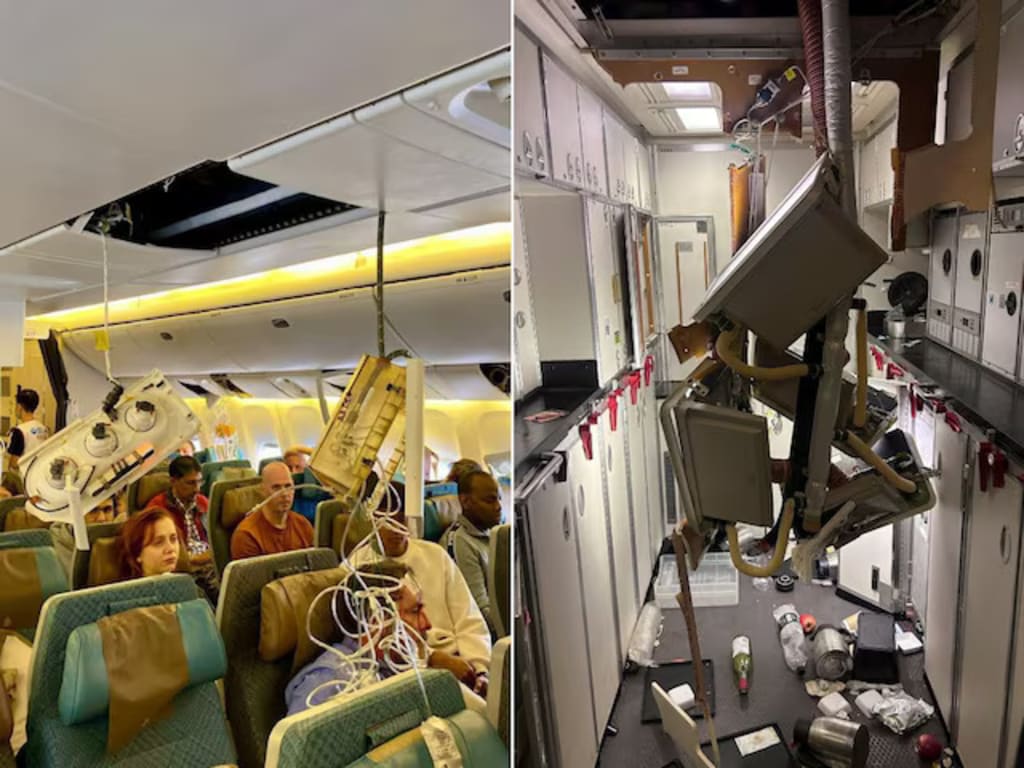Why Did Singapore Flight Hit Severe Turbulence?
Unexpected Flight Path

On May 20-21, a Singapore Carriers flight, SQ321, with 211 passengers and 18 crew, from London's Heathrow Airport to Singapore experienced extreme disturbance while over the Andaman Ocean/Bay of Bengal close to the Irrawaddy Basin, Myanmar. A passenger died and a few others endured wounds of differing degrees. The crew chose to redirect the Boeing 777-312ER to Bangkok, Thailand. The United States National Transportation Safety Board (NTSB) is to assist Singapore’s investigation — also because the aircraft is a Boeing jet.
Granular flight information shows the airplane dropping quickly before the crew started ("controlled") descent from 37,000 feet to 31,000 feet. It additionally shows the aircraft had an elevation deviation before this.
Turbulence happens "by the relative movement of disturbed air through which an aircraft is flying". It may be thermal or mechanical and can occur "either inside or when it is clear of cloud". Its seriousness relies upon the "rate at which the speed or the direction of airflow/or the two changes".
According to Professor Guy Gratton, Associate Professor of Aviation and the Environment at Cranfield University, U.K., turbulence is basically what happens when there is friction between airflow or wind flowing in different directions. When it involves aviation, there are two main forms, which are Clear Air Turbulence (CAT), which happens around jet streams, and other being inside or around cumulonimbus clouds. These clouds have very strong upward air currents in the middle and downward air currents around the outside, he explains, which can result in quite serious turbulence. The faster an aircraft is the more severe the response to the turbulence.
Prof. Richard Dale, Senior Lecturer in Aviation and Tourism at the University of West London, says turbulence consists of changes in the movement of air that the aircraft is moving through over a short distance. For example, there might be updrafts that are quickly followed by downdrafts but also changes in the horizontal movement of the air. The movement of the air, to some degree, is random and unpredictable, although the location where turbulence will be encountered is more certain. These changes cause the lift produced by the aircraft wing to change for a short time, forcing the aircraft up or down, suddenly and unexpectedly. According to A.D. Ravishankar, former Director, of Aviation Meteorology, India Meteorological Department, CAT is turbulence suffered by an aircraft above 18,000 feet.
Dr. Paul Williams, Professor of Atmospheric Science at, the University of Reading, U.K., says that turbulence fatalities on commercial flights are, fortunately, very rare. Turbulence on flights can be caused by storms, mountains, and strong air currents called jet streams. In this last case, it is called clear air turbulence and can be difficult to avoid because it does not show up on the weather radar in the flight deck. He adds that a detailed analysis of the meteorological circumstances and the type of turbulence that affected the Singapore Airlines flight will take some time. He also says that there is strong evidence that turbulence is increasing because of climate change. “We recently discovered that severe clear air turbulence in the North Atlantic has increased by 55% since 1979. Our latest future projections indicate a doubling or trebling of severe turbulence in the jet streams in the coming decades if the climate continues to change as we expect.”
Will passenger injuries lead to litigation?
As visuals from the Singapore incident show, there has been serious injury to certain passengers. Injuries occur from passengers not wearing their seat belts resulting in them being violently thrown from their seats, the overhead bins opening causing items to fall, the cabin ceiling and panels coming off and hot beverages causing burn injuries.
Turbulence injuries have brought about the acknowledgment that triumphant a turbulence guarantee needs expertise and information on the factors that caused the incident. Aviation attorneys work with aviation and climate specialists to plot the airplane's course, get satellite pictures of the climate at that point and area of the experience, and rapidly tie down aircraft information to assist with demonstrating the case. They even looked at whether the crew knew there was bad weather ahead but decided not to deviate to save time, fuel, and airline money.
What about technology in flight planning?
Bill Duncan, aviation forecast operations leader at The Weather Company (a weather forecasting and information technology company) has said that there is a cycle behind a dispatcher or pilot arranging a course, which incorporates meteorologists seeing flight arranging direction outlines. There is additionally a representing year-round turbulence affected by environmental change. Outrageous climate occasions have ascended in seriousness beginning around 2000.
As per Mr. Duncan, there is no question that there is warming going on, which can affect and gap the fly stream. "As the fly stream clasps a piece since it isn't areas of strength for however it seemed to be previously, you have this energy related with the fly stream up 30,000 feet or something like that, which is permitting colder air to spill south". So the world is witnessing significant climate occasions happening on a more regular basis.
Aviation meteorologists utilize model information, atmospheric condition acknowledgment, and experience to assist with distinguishing these areas of likely turbulence. Pilots advance reports out beyond their course on announced disturbances, and dispatchers are in touch with neighborhood meteorologists who effectively watch courses and issue Flight Planning Guidance Charts (FPGs) and Significant Meteorological Information (SIGMETs). These SIGMETs are the data that the dispatcher can hand off to the pilot about unsafe climate. With upgrades in innovation and science, there are better mathematical climate expectation models. The Weather Organization, for example, has a Global high-resolution Atmospheric Forecasting model that simulates the physics of the atmosphere to predict the weather and also uses artificial intelligence (AI) techniques that expand on weather conditions conjectures to anticipate choppiness and other flying dangers. Mr. Duncan adds that AI calculations and artificial intelligence are being utilized to track down the connections between verifiable climate and perceptions of disturbance. Separately, more than 20 airlines currently partake in the International Air Transport Association's 'Turbulence Aware Stage'.
About the Creator
shanmuga priya
I am passionate about writing.
Enjoyed the story? Support the Creator.
Subscribe for free to receive all their stories in your feed. You could also pledge your support or give them a one-off tip, letting them know you appreciate their work.






Comments (2)
People who were on the airplane during the incident likely developed trauma.
Hey, just wanna let you know that this is more suitable to be posted in the FYI community 😊